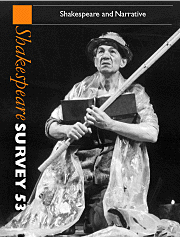Book contents
- Frontmatter
- Shakespeare’s Narremes
- Stepping Out of Narrative Line: A Bit of Word, and Horse, Play in Venus and Adonis
- A ‘consummation devoutly to be wished’: The Erotics of Narration in Venus and Adonis
- Echoes Inhabit a Garden: The Narratives of Romeo and Juliet
- A Midsummer Night’s Dream: Comedy as Apotrope of Myth
- Plutarch, Insurrection, and Dearth in Coriolanus
- Shakespeare, Crossing the Rubicon
- Vernacular Criticism and the Scenes Shakespeare Never Wrote
- The Shadow of Lear’s ‘Houseless’ in Dickens
- Shakespearian Margins in George Eliot’s ‘working-day world’
- In Her Father’s Library: Margaret Fuller and the Making of the American Miranda
- The Magician in Love
- Narrative Approaches to Shakespeare: Active Storytelling in Schools
- Monsters, Magicians, Movies: The Tempest and the Final Frontier
- Shakespeare’s Self-Repetitions and King John
- Inside Othello
- The View of London from the North and the Playhouses in Holywell
- Measured Endings: How Productions from 1720 to 1929 Close Shakespeare’s Open Silences in Measure for Measure
- Shakespearian Utopias
- Shakespeare Performances in England, 1999
- Professional Shakespeare Productions in the British Isles January–December 1998
- The Year's Contributions to Shakespearian Study 1 Critical Studies
- 2 Shakespeare’s Life, Times, and Stage
- 3 Editions and Textual Studies
- Books Received
- Index
Stepping Out of Narrative Line: A Bit of Word, and Horse, Play in Venus and Adonis
Published online by Cambridge University Press: 28 March 2007
- Frontmatter
- Shakespeare’s Narremes
- Stepping Out of Narrative Line: A Bit of Word, and Horse, Play in Venus and Adonis
- A ‘consummation devoutly to be wished’: The Erotics of Narration in Venus and Adonis
- Echoes Inhabit a Garden: The Narratives of Romeo and Juliet
- A Midsummer Night’s Dream: Comedy as Apotrope of Myth
- Plutarch, Insurrection, and Dearth in Coriolanus
- Shakespeare, Crossing the Rubicon
- Vernacular Criticism and the Scenes Shakespeare Never Wrote
- The Shadow of Lear’s ‘Houseless’ in Dickens
- Shakespearian Margins in George Eliot’s ‘working-day world’
- In Her Father’s Library: Margaret Fuller and the Making of the American Miranda
- The Magician in Love
- Narrative Approaches to Shakespeare: Active Storytelling in Schools
- Monsters, Magicians, Movies: The Tempest and the Final Frontier
- Shakespeare’s Self-Repetitions and King John
- Inside Othello
- The View of London from the North and the Playhouses in Holywell
- Measured Endings: How Productions from 1720 to 1929 Close Shakespeare’s Open Silences in Measure for Measure
- Shakespearian Utopias
- Shakespeare Performances in England, 1999
- Professional Shakespeare Productions in the British Isles January–December 1998
- The Year's Contributions to Shakespearian Study 1 Critical Studies
- 2 Shakespeare’s Life, Times, and Stage
- 3 Editions and Textual Studies
- Books Received
- Index
Summary
Imperiously he leaps, he neighs, he bounds,
And now his woven girths he breaks asunder;
The bearing earth with his hard hoof he wounds,
Whose hollow womb resounds like heaven’s thunder;
The iron bit he crusheth ’tween his teeth,
Controlling what he was controllèd with.
Picked out in bold type here is a piece or ‘bit’ of word-play in Shakespeare’s erotic narrative poem Venus and Adonis, which has not been noticed, or at least not recorded, and which has ramifications far and beyond its immediate context which I shall explore in what follows. Briefly, it consists in a verbal mimesis of the violence done by the horse to its ‘iron bit’, an image which thus acquires an emblematic metatextual significance as well as inter- and extra- textual significances. More precisely, the formation of ‘tween’ from between – a formation exemplary of poetic linguistic licence, as I shall indicate – is reactivated by a virtual homophone of the elided syllable or ‘bit’ before the verbal phrase ‘he crusheth. Releasing the polyvalency of the word bit this evokes at the same time its relation to the word bite, from which it is formed (again by elision), together with the relation of both to the body’s organs of articulation (‘tween his teeth’). Evoking these relations this bit of word-play makes them new, illustrating a poetics of recreative licence, a stepping out from narrative and syntactic linearity in a discursive equivalent to the intemperance of holiday, which, breaking with common or ordinary discourse, liberates and regenerates desire in a pleasurable re-creation of relations, especially of the word to the body.
- Type
- Chapter
- Information
- Shakespeare SurveyAn Annual Survey of Shakespeare Studies and Production, pp. 12 - 24Publisher: Cambridge University PressPrint publication year: 2000
- 3
- Cited by

